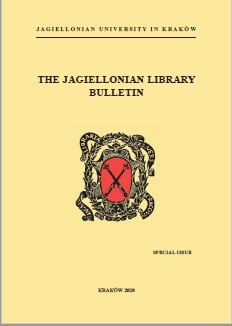ALMANACH PRO REVERENDISSIMO DOMINO CARDINALI FOR FRYDERYK JAGIELLOŃCZYK: THE HISTORICAL EVIDENCE OF AN ASTROLOGER’S WORKSHOP
ALMANACH PRO REVERENDISSIMO DOMINO CARDINALI FOR FRYDERYK JAGIELLOŃCZYK: THE HISTORICAL EVIDENCE OF AN ASTROLOGER’S WORKSHOP
Author(s): Ewa Śnieżyńska-Stolot Contributor(s): Dariusz Rossowski (Translator)
Subject(s): Cultural history, 16th Century, Theory of Literature
Published by: Biblioteka Jagiellońska
Keywords: Fryderyk Jagiellończyk, Galenus; horoscope; Joannes Lithuanus; bookbinder; Maciej Karpiga; Maciej Miechowita; Mikołaj Krzycki; French disease; forecast;
Summary/Abstract: Almanach (BJ, MS 8) consists of a title page (Fig. 1), the Astrological tables for the year 1501, two horoscopes for Fryderyk Jagiellończyk, i.e. the birth chart from 1568 (Fig. 2) and the anniversary chart (Fig. 3), which was cast on the day when the Sun marked the Cardinal’s 33rd birthday in 1501, twelve-monthly predictions for that year and an interpretation of those charts. In the final part of the Astrological tables, the years are not marked (p. 48) and the work closes (p. 50) with a quotation from Ovid’s poem (Tristia 5, 8, 15). The article concerning that part of the Almanach which contains the horoscopes and prognostics for Cardinal Fryderyk Jagiellończyk (pp. 28–46), is supplemented by two annexes. The first of these contains the whole text of Almanach, deciphered by Ryszard Tatarzyński and translated into Polish by Anna Kozłowska, annotated by Ewa Śnieżyńska-Stolot. Almanach was written by several people, the most notable of whom was the author of the charts and prognostics, probably identical with Maciej Karpiga, also called Miechowita, an astrologer, physician, historian and geographer, and an eight-time rector of the University of Kraków. In all probability, he hired a scribe who copied the Astrological tables for the year 1501, the charts, and the whole text. It was also him that, some time after the manuscript was completed, wrote down his own observations on its margins as well as on the Astrological tables and on the charts. The text of Almanach reveals the workshop of a medieval astrologer who interpreted charts in accordance with the order of the horoscopic houses (I Vita, II Lucrum, III Fratres, IV Parentes, V Filii, VI Valetudo, VII Nuptiae, VIII Mors, IX Peregrinationes, X Honores, XI Amici, XII Inimici). He also used astrolabium. His work is based on Matheseos libri VIII, written by the 4th-century Christian astrologer from Sicily, Julius Firmicus Maternus, and published in print in Venice in 1497, and, like its prototype, involves mythological characters such as Esculap (i.e. Asklepios), the patron god of physicians, and Mercury (i.e. Hermes Trismegistos) as well as historical figures such as the Egyptian priest Petosiris and the Neoplatonic philosophers Plotinus and Porphyrius.
Journal: Biuletyn Biblioteki Jagiellońskiej
- Issue Year: 2020
- Issue No: Sp. Issue
- Page Range: 65-136
- Page Count: 76
- Language: English

